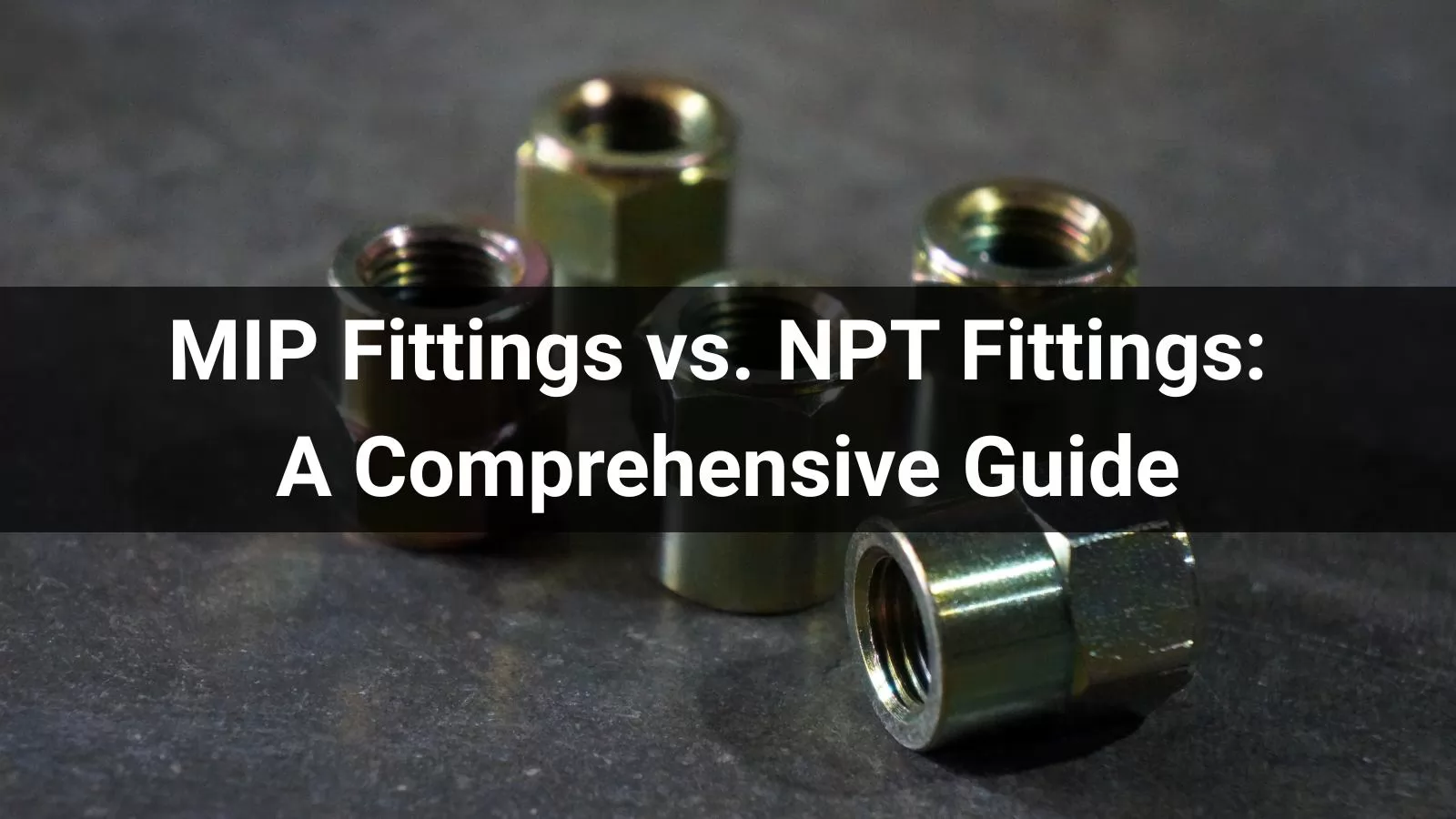MIP Fittings vs. NPT Fittings: A Comprehensive Guide

Pipe fittings are the backbone of any plumbing or hydraulic system, ensuring secure connections and leak-free performance. Among the most widely used fittings are MIP (Male Iron Pipe) and NPT (National Pipe Taper) fittings. While both serve similar purposes, their differences in design and application can significantly impact system efficiency and safety. This comprehensive guide explores MIP and NPT fittings in detail, offering professionals, contractors, and DIY enthusiasts the insights needed to choose the right fitting for their projects. Whether you're upgrading a residential plumbing system or designing an industrial hydraulic setup, understanding these fittings is crucial.
Table of Content
- What Are MIP Fittings?
- What Are NPT Fittings?
- Key Differences Between MIP and NPT Fittings
- How to Choose Between MIP and NPT Fittings
- Installation Best Practices
- 1. Are MIP and NPT fittings interchangeable?
- 2. Which fitting is better for high-pressure systems?
- 3. Can I use plastic NPT fittings with metal MIP fittings?
- 4. How do I measure thread size for MIP and NPT?
- 5. What sealants work best for each fitting type?
- Conclusion
What Are MIP Fittings?
Definition and Overview
MIP stands for Male Iron Pipe, a type of threaded fitting with external (male) threads designed to screw into a corresponding female fitting. Despite the name, MIP fittings are not exclusively made of iron—they can be crafted from various materials to suit different applications.
Design and Threading
MIP fittings feature straight, parallel threads, meaning the thread diameter remains consistent along the fitting's length. This design ensures a robust mechanical connection but often requires additional sealing materials to achieve a leak-proof joint.
Common Materials
MIP fittings are typically made from durable materials such as:
- Iron: Ideal for heavy-duty applications.
- Brass: Corrosion-resistant, suitable for water and gas systems.
- Stainless Steel: Preferred for high-pressure and harsh environments.
- Copper: Used in specialized plumbing systems.
Typical Applications
MIP fittings excel in high-pressure environments, making them a staple in:
- Industrial piping systems (e.g., oil and gas).
- Commercial plumbing for water and gas lines.
- Heavy-duty hydraulic systems.
Advantages and Limitations
Advantages:
- Robust and durable, ideal for high-pressure systems.
- Compatible with a wide range of female fittings.
- Available in corrosion-resistant materials.
Limitations:
- Straight threads require sealants like pipe dope for leak prevention.
- Less versatile for low-pressure residential applications.
What Are NPT Fittings?
Definition and Overview
NPT, or National Pipe Taper, is the U.S. standard for tapered threads used in pipe fittings. NPT fittings are designed to create a tight, self-sealing connection, making them popular across various industries.
Design and Threading
NPT fittings have tapered threads, meaning the thread diameter decreases along the fitting’s length. This taper creates an interference fit that compresses as the fitting is tightened, forming a reliable seal without excessive reliance on sealants.
Common Materials
NPT fittings are available in:
- PVC: Common in low-pressure residential plumbing.
- Brass: Versatile for water, gas, and hydraulic systems.
- Stainless Steel: Used in corrosive or high-pressure environments.
- Cast Iron: Found in older plumbing systems.
Typical Applications
NPT fittings are widely used in:
- Residential plumbing for water supply lines.
- Low-pressure systems like HVAC and irrigation.
- Gas transportation in controlled environments.
Advantages and Limitations
Advantages:
- Tapered threads provide a strong, leak-resistant seal.
- Easy to install with minimal sealant (e.g., Teflon tape).
- Versatile for various pipe materials and applications.
Limitations:
- Less suitable for extremely high-pressure systems compared to MIP.
- Tapered design may limit compatibility with straight-threaded fittings.
Key Differences Between MIP and NPT Fittings
Understanding the distinctions between MIP and NPT fittings is essential for selecting the right component. Below is a detailed comparison:
1. Thread Design
- MIP: Straight, parallel threads maintain a consistent diameter, relying on mechanical strength for connection.
- NPT: Tapered threads narrow toward the end, creating a tighter seal through thread deformation.
2. Sealing Methods
- MIP: Requires pipe dope (a paste sealant) or gaskets to prevent leaks due to straight threads.
- NPT: Typically uses Teflon tape (PTFE tape) for sealing, though pipe dope is also compatible.
3. Pressure Handling
- MIP: Excels in high-pressure environments (e.g., industrial hydraulics, gas pipelines).
- NPT: Better suited for low to moderate pressure systems (e.g., residential water lines).
4. Material Compatibility
- MIP: Predominantly metal (iron, brass, stainless steel), ensuring durability.
- NPT: Available in both metal and plastic (PVC), offering flexibility for lighter applications.
5. Application Suitability
- MIP: Preferred in industrial and commercial settings where strength is paramount.
- NPT: Common in residential and light commercial plumbing for ease of use.
6. Compatibility and Interchangeability
While MIP and NPT fittings share a 60-degree thread angle, their thread shapes (straight vs. tapered) mean they are not always interchangeable. Connecting a MIP fitting to an NPT female port may require extra sealant to ensure a tight seal, and vice versa.
How to Choose Between MIP and NPT Fittings
Selecting the right fitting depends on your project’s requirements. Follow these steps to make an informed decision:
Factors to Consider
- Pressure Requirements: High-pressure systems favor MIP; low-pressure systems suit NPT.
- Environment: Corrosive settings demand stainless steel or brass fittings.
- Material Compatibility: Ensure fittings match the pipe material (e.g., metal with metal).
- Budget: Plastic NPT fittings are often more affordable than metal MIP fittings.
Step-by-Step Guide
- Assess System Needs: Determine the pressure, temperature, and fluid type.
- Measure Pipe Size: Use a thread gauge to confirm the diameter and TPI (threads per inch).
- Check Thread Type: Verify whether straight (MIP) or tapered (NPT) threads are required.
- Select Material: Choose based on durability and environmental factors.
- Consult Standards: Ensure compliance with ANSI/ASME B1.20.1 for NPT or relevant codes for MIP.
Common Mistakes to Avoid
- Mixing MIP and NPT without proper sealing.
- Overtightening, which can damage threads or cause leaks.
- Ignoring material compatibility, leading to corrosion or failure.
Expert Tips
- Always clean threads before installation to remove debris.
- Use high-quality sealants to enhance durability.
- Test connections under low pressure before full operation.
Installation Best Practices
Proper installation ensures the longevity and reliability of MIP and NPT fittings. Follow these guidelines:
Tools and Materials Needed
- Pipe wrench or adjustable wrench
- Thread gauge
- Teflon tape (for NPT) or pipe dope (for MIP)
- Wire brush for cleaning threads
- Safety gloves and goggles
Preparing Threads
- Inspect threads for damage or debris.
- Clean with a wire brush to ensure a smooth surface.
- Verify thread compatibility using a gauge.
Applying Sealants
- For NPT: Wrap Teflon tape clockwise around male threads, covering 3–5 threads.
- For MIP: Apply a thin, even layer of pipe dope to male threads, avoiding excess.
Tightening Techniques
- Hand-tighten the fitting to avoid cross-threading.
- Use a wrench to turn 1–2 additional turns, stopping before excessive resistance.
- Check alignment to ensure the fitting is secure.
Safety Precautions
- Wear gloves to protect against sharp threads.
- Avoid overtightening, which can crack fittings.
- Test for leaks with soapy water after installation.
FAQs About MIP and NPT Fittings
1. Are MIP and NPT fittings interchangeable?
MIP (Male Iron Pipe) and NPT (National Pipe Taper) fittings both feature a 60-degree thread angle, which might suggest compatibility, but their thread designs differ significantly. MIP fittings have straight, parallel threads, requiring sealants like pipe dope to prevent leaks, while NPT fittings use tapered threads that create a self-sealing interference fit. Connecting them is possible but risky—mismatched threads can lead to leaks or weak joints, especially under pressure. To ensure a secure connection, use ample Teflon tape or pipe dope and test for leaks with soapy water. For guaranteed compatibility, stick to matching thread types or explore hybrid adapters from trusted suppliers like HGW Hydraulic, which offers solutions for complex piping systems.
2. Which fitting is better for high-pressure systems?
MIP fittings are typically better suited for high-pressure systems, such as industrial hydraulic setups or gas pipelines, due to their robust straight-thread design and durable materials like brass or stainless steel. These fittings excel in environments with pressures exceeding 1000 PSI, offering reliable mechanical strength. In contrast, NPT fittings, with their tapered threads, are optimized for low to moderate pressures, commonly found in residential plumbing or HVAC systems (up to 300 PSI for water). The choice depends on your system’s demands—high-pressure applications favor MIP for durability, while NPT suffices for standard plumbing. Always check the fitting’s pressure rating and consult experts at HGW Hydraulic for tailored recommendations to ensure safety and performance.
3. Can I use plastic NPT fittings with metal MIP fittings?
Yes, plastic NPT fittings can be paired with metal MIP fittings, but careful installation is crucial to avoid issues. Plastic NPT fittings, often made of PVC or CPVC, are cost-effective and corrosion-resistant, ideal for low-pressure water systems. Metal MIP fittings, typically brass or stainless steel, are stronger and suited for high-pressure or industrial use. When combining them, the straight threads of MIP and tapered threads of NPT may not seal perfectly, increasing leak risks. Apply Teflon tape clockwise over the NPT threads or pipe dope on the MIP threads to enhance sealing. However, mixed materials can lead to differential expansion or cracking under temperature changes. Test connections thoroughly and consider metal-to-metal or plastic-to-plastic fittings for critical systems to ensure longevity.
4. How do I measure thread size for MIP and NPT?
Accurately measuring thread size for MIP and NPT fittings is essential for a secure, leak-free connection. Start by using a caliper to measure the outer diameter of male threads or the inner diameter of female threads, typically in inches (e.g., 1/2-inch, 3/4-inch). Next, count the threads per inch (TPI) with a thread gauge—for instance, a 1/2-inch NPT fitting has 14 TPI, while a 1/2-inch MIP fitting may also have 14 TPI but differs in thread shape. Visually inspect the threads: MIP threads are straight, while NPT threads taper. If unsure, compare against a thread chart or test with a known fitting. Incorrect sizing can cause cross-threading or leaks, so double-check measurements. For precision tools and fittings, visit HGW Hydraulic.
5. What sealants work best for each fitting type?
Choosing the right sealant is critical for leak-free MIP and NPT connections. For NPT fittings, Teflon tape (PTFE tape) is the go-to choice—wrap it clockwise around male threads, covering 3–5 threads, to fill gaps in the tapered design. It’s easy to apply and ideal for water or gas lines. For MIP fittings, pipe dope (thread sealant paste) is preferred, as straight threads don’t self-seal; apply a thin, even layer to male threads for a robust seal. While both fittings can use either sealant, pipe dope offers extra durability in high-pressure MIP systems, while Teflon tape suits NPT’s versatility. Avoid over-application to prevent clogs or weak joints, and always clean threads first. For high-quality sealants, check HGW Hydraulic’s accessories.
Conclusion
Selecting between MIP and NPT fittings is a critical decision that impacts the efficiency and reliability of your plumbing or hydraulic system. MIP fittings, with their robust straight threads, are ideal for high-pressure industrial applications, while NPT fittings, featuring tapered threads, excel in residential and low-pressure environments. By evaluating factors such as pressure requirements, material compatibility, and installation needs, you can make an informed choice that ensures leak-free performance and long-term durability.
For premium fittings and expert guidance, trust HGW Hydraulic, a leader in high-quality hydraulic and plumbing solutions. Explore our extensive range of MIP and NPT fittings to find the perfect match for your project. Save this guide for future reference, share it with your team, and partner with HGW Hydraulic to elevate your systems to the next level!
-
2025 Shanghai Bauma Exhibition China International Construction Machinery ExhibitionUpdate on 2024-12-25
-
2025 Las Vegas International Mining ExhibitionUpdate on 2024-12-25
-
Leading the High-End and Empowering the World | Bauma China 2025, Hgw Successfully ConcludedUpdate on 2024-12-25
-
Hgw's Multi-field Hydraulic Products Appeared at the Exhibition丨MINEXPOUpdate on 2024-12-25
-
2025 PTC ASIAUpdate on 2025-02-12
-
Top 10 Leading Hydraulic Fitting Companies in the World[2025 Updated]Update on 2025-02-27
-
Top 10 Global Suppliers of Hydraulic Hose FittingsUpdate on 2025-03-04
-
HGW's O-Ring Face Seal Fittings(ORFS): From Core to Best UseUpdate on 2025-03-08















